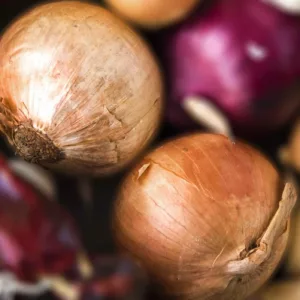Yellow onion vs. sweet onion? Shallot vs. red onion? Don't be confused by all the choices. Use this handy guide to help you make the decision!
Onions add a lot of flavor to your dishes, but when you go to the grocery store, you are confronted with so many options for onions! Each type of onion has a different flavor profile and texture, but what if your recipe calls for just “onions”? Which kind of onion do you choose and how do you pick an onion at the grocery store? And when you get home, how do you store onions?
Whether you are stir frying, braising, or making a guacamole, this handy guide will help you make the decision! Bookmark it for quick reference!
Quick Links
Sweet Onion | White Onion | Yellow Onion | Red Onion | Shallot

Sweet! Lacking sharpness.
Frying.
Onion rings, gratins, caramelizing, and roasted with vegetables.
Look for a heavy and firm onion with skin that’s free of bruises.
Keep skin on and keep stored in fridge’s crisper drawer with humidity vent closed. Can also be frozen. Do not store with potatoes.

Sharp, strong, and pungent.
Adding a crunchy texture and a sharp zing to your dish!
Salsas, stir-fries, and chutneys.
Look for a heavy and firm onion with thin and papery white skin that’s free of bruises.
Keep skin on, take out of plastic bag, and store in a dark, dry, cool, and well-ventilated location.

Balance of sharpness and sweetness. Yellow onions will get sweeter the longer you cook them.
Most versatile; all-found cooking onion.
Pot roasts, braising, sauces, stews, and soups.
Look for a heavy and firm onion with skin that’s free of bruises.
Keep skin on, take out of plastic bag, and store in a dark, dry, cool, and well-ventilated location.

Mild. Red onions will get sweeter the longer you cook them.
Eating raw.
Guacamole, sandwiches, salads, and pickled onions.
Look for a heavy and firm onion with vibrant red skin that’s free of bruises.
Keep skin on, take out of plastic bag, and store in a dark, dry, cool, and well-ventilated location.

Delicate, soft, and subtle.
Applications where you want the onion to blend into the background; not be the star of the show.
Garnishing, vinaigrettes, and egg casseroles.
Look for a heavy and firm shallot with vibrant red skin that’s free of bruises. Avoid dried-out shallots, shallots that are sprouting, and shallots with soft spots.
Keep skin on, take out of plastic bag, and store in a dark, dry, cool, and well-ventilated location.
Sizzle and Sear Kitchen Equipment Deal Alerts In Your Inbox
Did you find this guide handy? Let us know your favorite ways to use onions in the comments below.
